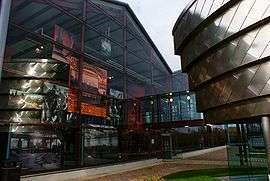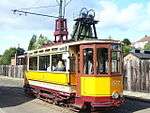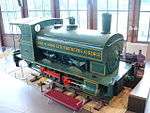Summerlee, Museum of Scottish Industrial Life

Summerlee Museum of Scottish Industrial Life, formerly known as Summerlee Heritage Park, is an industrial museum in Coatbridge, North Lanarkshire, Scotland. It was built on the site of the Victorian Summerlee Iron Works and incorporated the main workshop of the former Hydrocon Crane factory. The museum is managed by CultureNL Ltd.
It temporarily closed in 2006, but reopened on 26 September 2008 following a £10m refurbishment (pictured right).
The former main hall was completely redesigned by North Lanarkshire Council's in-house Design Team and now includes a stainless steel café pod and futuristic viewing pavilion. The museum aims to show Lanarkshire's contribution to engineering, mining, steel working, weaving & farming and also show the lives of the people of the area. It incorporates interactive displays and a temporary exhibition space.
The museum also incorporates several railway steam locomotives, preserved carriages from a 1960s era Glasgow Class 311 and has a short working tram line.
The Miners’ Row
Built in 1991-2, the miners’ row, or ‘raw’ shows typical workers’ homes from the 1880s to the 1980s. In the row there is also a sweet shop selling old fashioned sweets and some of modern houses have gardens such as the 1940s house which has a wartime ‘dig for victory’ garden with Anderson shelter. The row is used frequently as a location for filming.
Tramway
In the late 1980s, the Summerlee Transport Group (STG) was formed, in order to support the maintenance and operation of the tramway.[1] The original tramway used to terminate only 300 yards from the entrance at the timber shed, before the extension of the Gartsherrie Branch canal bridge and thence towards the Miners' Cottages. As continued tradition, the cars still halt at the timber shed before continuing over the bridge and around the bend.
The tramway opened in 1988 and was the first operational tramway in Scotland for over a quarter of a century, following the closure of the Glasgow Corporation Tramway in 1962, and continued to be the only tramway in Scotland for twenty-six years until Edinburgh reopened its tramway in 2014, save from the Glasgow Garden Festival Tramway, which opened six weeks after the Summerlee Line.
Whilst the first two operational trams at Summerlee were continental cars, it has always been the intention to use traditional British cars, preferably with local connections, which is now being realized.
| Original System | Car Number | Built | Date Acquired | Seats | Livery | Status | Notes | Image |
|---|---|---|---|---|---|---|---|---|
| Lanarkshire Tramways Company | 53 | 1908 | 1995 | 59 | Green and white | Operational | Open-top double-decker |  |
| Düsseldorf | 392 | 1951 | 1999 | 10 | Cream | Operational | Wheelchair access tram from Germany |  |
| Glasgow Corporation Tramways (Ex. Paisley and District Tramways) | 1017 (Ex. Paisley 17) | 1904 | ? | 20 | Orange and cream | Operational | Single Decker (ex. Double Decker) - Glasgow "School" Car with raised floor. The raised floor promoted better visibility for trainee drivers receiving instruction from the motorman |  |
| Glasgow Corporation Tramways | 1245 | 1939 | 2002 | 64 | Orange, green and cream | Currently undergoing long-term restoration | Coronation Class Tram |
|
| Brussels Tramway Network | 9062 | 1959 | 1988 | unknown | Cream | Scrapped in 2004 after act of vandalism | First operation tram at Summerlee, and first operational tram in Scotland for 26 years. |  |
| Graz Tramway Network | 225 | 1949 | 1988 | unknown | Purple | Sold to the Brighton Tram 53 Society in 2010 | Restored to its former glory whilst at Summerlee, but later deemed surplus to requirements. It has since fallen into disrepair again. |  |
Railway Rolling Stock
| Name | Number | Builder | Type | Date | Works number | Livery | Notes | Image |
|---|---|---|---|---|---|---|---|---|
| 11 | Gibb and Hogg, Airdrie | 0-4-0ST | 1898 | 16 | Dark Green | Worked for Fife coal company and later N.C.B. Fife area. Later displayed in Pittencrief Park, Dunfermline. Only surviving locomotive from this builder. On display in exhibition hall. |  | |
| 9 | Hudswell Clarke | 0-6-0T | 1909 | 895 | Light Green | Worked for Fife Coal company and later N.C.B. Fife area. Open air display alongside mainline railway. | ||
| Springbok | 4112 | North British Locomotive Co. | 4-8-2+2-8-4 Garratt | 1956 | 27770 | Black | 3 ft 6 in (1,067 mm) gauge South African Railways GMAM Class. Repatriated c.1988. Open air display outside exhibition hall. Owned by Springburn Museum. |  |
| Robin | Sentinel | 4wVB | 1957 | 9628 | Blue | Worked at R.B. Tennants, Whifflet Foundry, Coatbridge. Open air display alongside mainline railway. | ||
| 5 | Barclay | 0-4-0DH | 1966 | 472 | Red | Open air display alongside mainline railway. |
| Unit | Number | Builder | Type | Date | Livery | Notes |
|---|---|---|---|---|---|---|
| 936103 (311103) | 977844 (76433) | Cravens | BDTCOL | 1967 | Blue | Designated "historically important" by the Railway Heritage Committee. |
| 936103 (311103) | 977845 (62174) | Cravens | MBSO | 1967 | Blue | This vehicle contained the sandite tank |
| 936103 (311103) | 977846 (76414) | Cravens | DTSO | 1967 | Blue | Scrapped August 2006 by CF Booth, Rotherham. Bogies sold to VSOE for use under pullman coaches. |
Other transportation
- A replica of the 1819 barge Vulcan (barge), the first all-iron hulled vessel, built for the Glasgow Garden Festival in 1988. The replica is probably the last hand riveted boat built on the Clyde and was Summerlee Museum and Monklands District Council's entry into the Festival.
In 2016, it was re-sited on the Monkland Canal, the Gartsherrie Cut runs through the site, following refurbishment with the aid of Scottish Waterways, Scottish Canals and the Heritage Lottery Fund. It rests on a cradle, slightly proud of the water and is fully accessible for visitors.
See also
- Beamish Museum - an industrial museum in the North East of England
- Black Country Living Museum - an industrial museum in the West Midlands conurbation
- East Anglia Transport Museum - a transport museum in Suffolk
- Riverside Museum (Glasgow Museum of Transport)
- Titan Clydebank
- Scottish Maritime Museum
- National Tramway Museum, - located in Crich, Derbyshire
- The Trolleybus Museum at Sandtoft
- St Fagans National History Museum - Museum of Welsh Life, Cardiff, Wales.
References
- ↑ "The Summerlee Transport Group". The Summerlee Transport Group.
External links
| Wikimedia Commons has media related to Summerlee Industrial Museum. |
- Summerlee, Museum of Scottish Industrial Life - North Lanarkshire Council's "Summerlee Museum of Scottish Industrial Life" official website
- Details from Visit Lanarkshire
